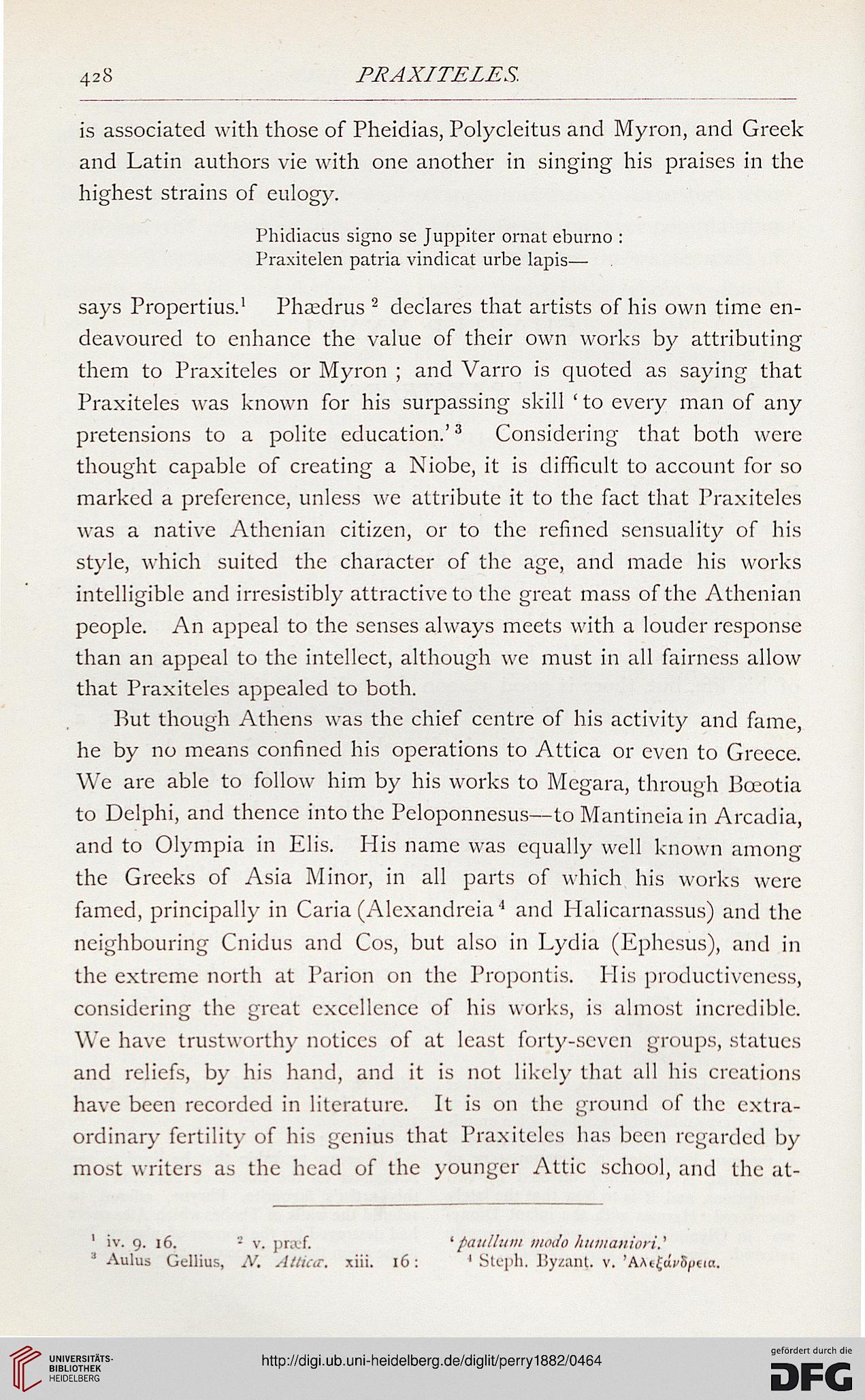428
PRAXITELES.
is associated with those of Pheidias, Polycleitus and Myron, and Greek
and Latin authors vie with one another in singing his praises in the
highest strains of eulogy.
Phidiacus signo se Juppiter ornat eburno :
Praxitelen patria vindicat urbe lapis—
says Propertius.1 Phaedrus 2 declares that artists of his own time en-
deavoured to enhance the value of their own works by attributing
them to Praxiteles or Myron ; and Varro is quoted as saying that
Praxiteles was known for his surpassing skill 'to every man of any
pretensions to a polite education.'3 Considering that both were
thought capable of creating a Niobe, it is difficult to account for so
marked a preference, unless we attribute it to the fact that Praxiteles
was a native Athenian citizen, or to the refined sensuality of his
style, which suited the character of the age, and made his works
intelligible and irresistibly attractive to the great mass of the Athenian
people. An appeal to the senses always meets with a louder response
than an appeal to the intellect, although we must in all fairness allow
that Praxiteles appealed to both.
Put though Athens was the chief centre of his activity and fame,
he by no means confined his operations to Attica or even to Greece.
We are able to follow him by his works to Megara, through Bceotia
to Delphi, and thence into the Peloponnesus—to Mantineiain Arcadia,
and to Olympia in Elis. His name was equally well known among
the Greeks of Asia Minor, in all parts of which his works were
famed, principally in Caria (Alcxandreia4 and Halicarnassus) and the
neighbouring Cnidus and Cos, but also in Lydia (Ephesus), and in
the extreme north at Parion on the Propontis. His productiveness,
considering the great excellence of his works, is almost incredible.
We have trustworthy notices of at least forty-seven groups, statues
and reliefs, by his hand, and it is not likely that all his creations
have been recorded in literature. It is on the ground of the extra-
ordinary fertility of his genius that Praxiteles has been regarded by
most writers as the head of the younger Attic school, and the at-
' iv. 9. 16. - v. pr;if.
3 Aulus Gellius, N. Attica, xiii. 16
1 iaullttm moJo humaniori.'
4 Stcph. Byzant. v. 'AAt£iii<5pein.
PRAXITELES.
is associated with those of Pheidias, Polycleitus and Myron, and Greek
and Latin authors vie with one another in singing his praises in the
highest strains of eulogy.
Phidiacus signo se Juppiter ornat eburno :
Praxitelen patria vindicat urbe lapis—
says Propertius.1 Phaedrus 2 declares that artists of his own time en-
deavoured to enhance the value of their own works by attributing
them to Praxiteles or Myron ; and Varro is quoted as saying that
Praxiteles was known for his surpassing skill 'to every man of any
pretensions to a polite education.'3 Considering that both were
thought capable of creating a Niobe, it is difficult to account for so
marked a preference, unless we attribute it to the fact that Praxiteles
was a native Athenian citizen, or to the refined sensuality of his
style, which suited the character of the age, and made his works
intelligible and irresistibly attractive to the great mass of the Athenian
people. An appeal to the senses always meets with a louder response
than an appeal to the intellect, although we must in all fairness allow
that Praxiteles appealed to both.
Put though Athens was the chief centre of his activity and fame,
he by no means confined his operations to Attica or even to Greece.
We are able to follow him by his works to Megara, through Bceotia
to Delphi, and thence into the Peloponnesus—to Mantineiain Arcadia,
and to Olympia in Elis. His name was equally well known among
the Greeks of Asia Minor, in all parts of which his works were
famed, principally in Caria (Alcxandreia4 and Halicarnassus) and the
neighbouring Cnidus and Cos, but also in Lydia (Ephesus), and in
the extreme north at Parion on the Propontis. His productiveness,
considering the great excellence of his works, is almost incredible.
We have trustworthy notices of at least forty-seven groups, statues
and reliefs, by his hand, and it is not likely that all his creations
have been recorded in literature. It is on the ground of the extra-
ordinary fertility of his genius that Praxiteles has been regarded by
most writers as the head of the younger Attic school, and the at-
' iv. 9. 16. - v. pr;if.
3 Aulus Gellius, N. Attica, xiii. 16
1 iaullttm moJo humaniori.'
4 Stcph. Byzant. v. 'AAt£iii<5pein.




